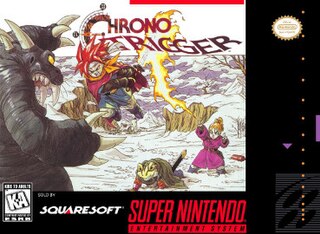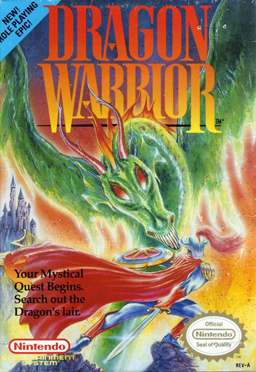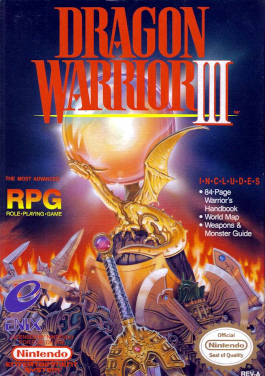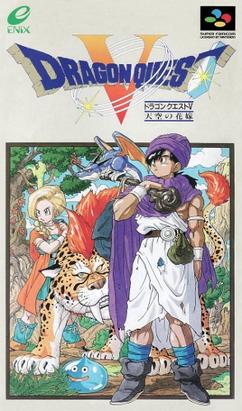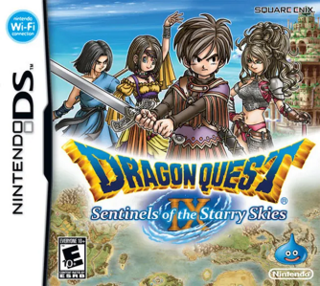Story
Dragon Quest VI opens as the Hero and his party of a mysterious woman and a bulky man approach Murdaw, the demon king's castle. [19] After the woman uses an ocarina to summon a dragon, the party enters the castle and comes face to face with the Dreadfiend Murdaw (Demon King Mudō "魔王ムドー" in Japanese version). Overpowering the trio, the demon king appears to destroy each member of the party, but suddenly, the Hero wakes up in the mountain town Weaver's Peak. Tania, a young woman from Weaver's Peak, insists that he was having a bad dream and introduces herself as his sister. [20]
After getting out of bed, the town elder tasks the Hero to get a crown in preparation for the annual Mountain Spirit festival, which takes him to Haggleton. The hero finds out the man who is supposed to make the crown has gone out somewhere to the northwest of town and never came back. The Hero heads in that direction and finds a large hole with the crown maker just barely hanging on. The hero attempts to rescue him and succeeds, but in the process, slips and falls to the world below. In this mysterious world, the Hero finds a nearby town in which the townspeople cannot see him. The Hero receives a tip from one of the townspeople: There is a special well to the north from which people who enter never come back; the Hero heads in that direction, enters the well, and returns to his world.
After receiving the ceremonial crown from the crown maker for no charge after saving his life, the Hero heads back to Weaver's Peak just in time for the festival to begin. During the festival, the Hero receives a mysterious vision that a great evil will take over the world; the elder asks him to leave the village in preparation for this disaster. The next day, the Hero finds out that the world that he stumbled onto was called the "Phantom World" and is given a pass by the elder that allows him entry into Somnia, where he can meet the king.
At Somnia, the Hero meets Carver, who does not seem to remember the Hero. The Hero then meets Captain Blade, leader of Somnia's military, who gives the potential soldier candidates a task to find a special item in a tower. The Hero manages to find this item successfully and formally becomes a soldier of Somnia. After a task, the Hero and Carver work together to obtain a horse for an old man. Carver also becomes a soldier of Somnia. The Hero and Carver speak to the king, who informs them that to defeat Murdaw, they need the Mirror of Ra. The Hero and Carver discover another portal similar to the one near Haggleton, which eventually leads them to Port Haven, another town where they can not be seen. Milly, also appearing to have lost her memory, sees them and helps them become visible via Madame Luca's help.
The party discovers a Somnia Castle in the “Phantom World” and learns that the prince—who looks like the Hero—is missing. They also meet Captain Rusty, who bears a striking resemblance to Captain Blade. Gaining entrance to the Moonmirror Tower, the party meets Ashlynn, a woman who was invisible in the “Phantom World” at first, too, and together they find the Mirror of Ra. The party travels to Murdaw's castle in the original world. After defeating Murdaw, the Hero uses the Mirror on him. Murdaw then turns into the King of Somnia, confused and unaware of what happened. The king reveals that the original world is in fact the Dream World and the Phantom World is the Real World. Upon traveling back to the Real World, the King of Somnia thanks the party for defeating Murdaw in his dreams, but the real Murdaw lives and that the party must travel to Ghent to retrieve a boat to get to Murdaw's lair. In Ghent, Nevan, a healer, joins the party and allows them to use the Ghent Clan's ship. During the fight with the real Murdaw, the Hero is again sent back to Weaver's Peak. With the Mirror of Ra, however, the Hero warps back into the battle and defeats Murdaw.
The Queen of Somnia tells the Hero to discover who he really is. This quest leads the party to Arkbolt, where a terrible monster is blocking a nearby cave. The reward for defeating the monster is the famed Sunderbolt Blade, but before the party can strike the final blow, a warrior by the name of Terry kills the monster, winning the sword. After traveling both worlds, the party learns that Murdaw was not the only evil in the world, having fought several other monsters that all seem to be connected.
In Sorceria, the party learns that this is Ashlynn's home. [21] The elders tell Ashlynn that the Demon Lord is watching her and give her the powerful spell Magic Burst to fight him. The party also learns that the only way to get to the Demon Lord is through Zenith Tower, but to activate the tower, they need to collect the sword, armor, shield, and helmet of legend. While doing so, the Hero meets his double in Real Weaver's Peak, who gets spooked, and speaks 'Y-You. Y-You're m-m-me!', and says that he must prove himself to be faithful to his family if he is to join powers. Returning to Real Somnia, the King and Queen tell the Hero that he is indeed the prince. [22] When he fused with his clone, the Hero gained his memory back, much like Ashlynn and Carver previously.
The party reaches Cloudsgate Citadel and meets Dhuran (デュラン), who claims to have taken over the castle. He summons Terry to fight the party and then fights the party himself. Dhuran then reveals that all the enemies the party has faced were just pawns of Mortamor, the Archfiend. Milly reveals that Terry is her brother and Terry decides to join the party and fight against Mortamor.
Once Cloudsgate Citadel returns to normal, the party speaks to King Zenith who informs them of Mortamor's doings and how to reach the Dread Realm. Mortamor plans on merging both worlds. [23] The party's horse fuses with Pegasus, allowing the party to fly to the Dread Realm. Several challenges await in the Dread Realm, including the party's strength suddenly and unexpectedly plummeting. With the help of two Supreme Sage brothers, Benjamin and Isaac, the party enters Mortamor's Castle. After solving many puzzles, they come face to face with Mortamor and defeat him. Isaac reveals that the Dread Realm is falling apart and Pegasus helps them escape. [24] After returning to the Real World, everyone parts ways, with Ashlynn having to return to the Dream World since her Real World self no longer exists. With Mortamor's link between the Real World and the Dream World severed, the Dream World vanishes, with only Cloudgate Castle remaining visible in the Real World. Ashlynn is then shown in the castle, taking care of the newly hatched Zenithian Dragon.


